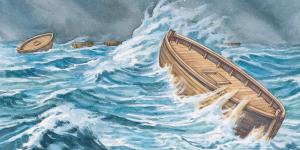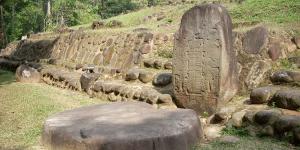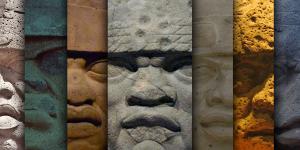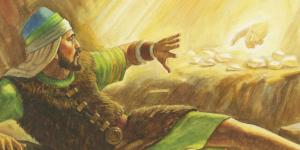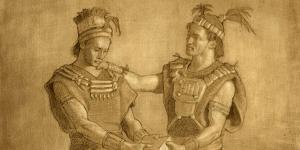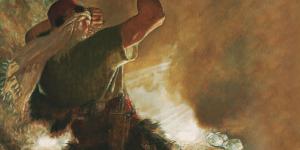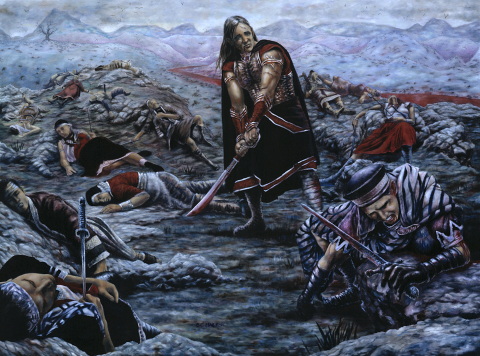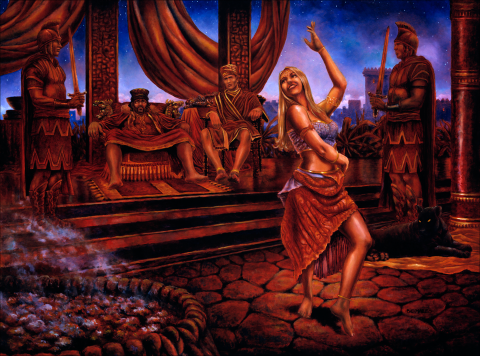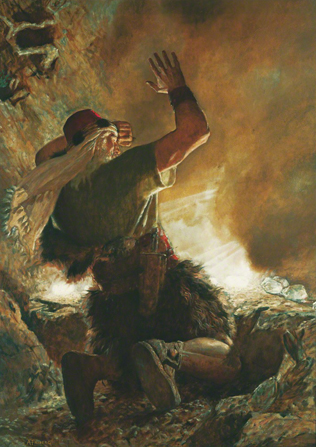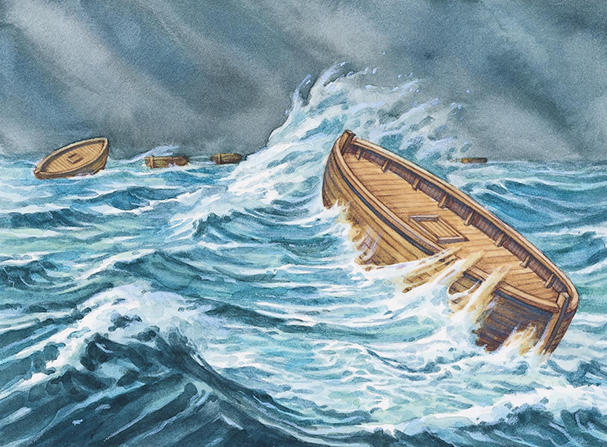You are here
Book of Mormon Central is in the process of migrating to our new Scripture Central website.
We ask for your patience during this transition. Over the coming weeks, all pages of bookofmormoncentral.org will be redirected to their corresponding page on scripturecentral.org, resulting in minimal disruption.

Scripture Block
Ether 1-6
To help class members understand from the example of the brother of Jared how faith can enable us to enter the presence of the Lord eternally.
Lesson Manual
KnoWhys
Articles
Ether Overview
Donaldson, Lee L. "The Plates of Ether and the Covenant of the Book of Mormon." In The Book of Mormon: Fourth Nephi Through Moroni, From Zion to Destruction, edited by Monte S. Nyman and Charles D. Tate, Jr., 69-79. Provo, UT: Religious Studies Center, 1995.
If the Book of Mormon was compiled in chronological order, the plates of Ether would be placed first. Donaldson proposes that Ether is placed at the end of the Book of Mormon because it lays out a clear covenant pattern to follow for disciples of Christ. The book of Ether serves as a reminder to all to keep their covenants or face destruction.
Brinley, Douglas E. "The Jaredites: A Case Study in Following the Brethren." In A Book of Mormon Treasury: Gospel Insights from General Authorities and Religious Educators, 427-441. Provo, UT: Religious Studies Center, 2003.
Brinley attributes the utter destruction of the Jaredite civilization to their failure to listen to the warnings and words of the prophets. He details the entire narrative, pointing out in which ways the Jaredites failed to follow their church leaders. It serves as a lesson for Latter-day Saints today to listen and follow the teachings of church leaders.
Valleta, Thomas R. "Jared and His Brother." In The Book of Mormon: Fourth Nephi Through Moroni, From Zion to Destruction, edited by Monte S. Nyman and Charles D. Tate, Jr., 303-322. Provo, UT: Religious Studies Center, 1995.
Valleta takes the two characters of Jared and his brother, and expounds on how their stories reflect various stories and truths throughout scripture. He sets up the story of the Jaredites as a type for the Plan of Salvation and a type for Jesus Christ.
LeBaron, E. Dale. "Ether and Mormon: Parallel Prophets of Warning and Witness." In The Book of Mormon: Fourth Nephi Through Moroni, From Zion to Destruction, edited by Monte S. Nyman and Charles D. Tate, Jr., 153-165. Provo, UT: Religious Studies Center, 1995.
This paper shows the similarities and differences of Ether and Mormon's ministries. Ether and Mormon were different in their backgrounds and situations, and similar in their missions and convictions.
Judd, Jr., Frank F. "Jaredite Zion Societies: Hope for a Better World." In The Book of Mormon: Fourth Nephi Through Moroni, From Zion to Destruction, edited by Monte S. Nyman and Charles D. Tate, Jr., 147-152. Provo, UT: Religious Studies Center, 1995.
While the record of the Jaredites is one of ultimate destruction and bloodshed, if one reads it as only a tale of wickedness and destruction, one misses Mormon's purpose in including it. The book of Ether serves as a warning to follow the teachings of Christ or risk suffering a similar fate. Additionally, Moroni provided in his abridgment of the Jaredite record the experiences of a few righteous societies, which show the modern reader how to overcome the darkness.
Sorenson, John L. "The Years of the Jaredites." 1968.
This piece provides an excellent overview of the Jaredite timeline. It details the dynastic line of the Jaredite kings and their corresponding years, noting the different periods of dissension and destruction among the Jaredites.
Sperry, Sidney B. "What the Book of Mormon Is (Concluded)." Journal of Book of Mormon Studies 4, no. 1 (1995): 28-40.
An analysis of the text of 3 Nephi to Moroni. Third Nephi was written by Nephi, the son of Nephi, the son of Helaman. Fourth Nephi in turn was written by the son of Nephi3 also called Nephi, and Nephi4‘s son Amos and grandsons Amos and his brother Ammaron. The book of Mormon was principally inscribed by Mormon and Moroni. The book of Ether exposes the terrible end of a people persisting in wickedness. The book of Moroni shows his love for his enemies.
Ether Commentaries and Reference Works
Reeve, Jr., Rex C. Brother of Jared In Encyclopedia of Mormonism, Edited by Daniel H. Ludlow. Vol. 1. New York: Macmillan, 1992.
An encyclopedic entry on the Brother of Jared.
Tanner, Morgan W. Jaredites In Encyclopedia of Mormonism, Edited by Daniel H. Ludlow. Vol. 2. New York: Macmillan, 1992.
An encyclopedic entry on the ancient civilization of the Jaredites.
Hyde, Paul Nolan. A Comprehensive Commentary of the Book of Ether. Orem, UT: Parrish Press, 2015.
Commentary on the Book of Ether
Preece, Michael J.. Learning to Love the Book of Mormon - The Book of Ether., 2014.
Commentary on the Book of Ether.
Miner, Alan C. "The Book of Ether, Chapter 1." In Step by Step through the Book of Mormon: A Collection of Cultural Commentary. Vol. 7. Springville, UT: N.P., 2016.
Commentary on the Book of Ether.
Skousen, Royal. Analysis of Textual Variants of the Book of Mormon Part Six: 3 Nephi 19 – Moroni 10 In The Critical Text of the Book of Mormon. Provo, UT: FARMS, 2014.
Reference work on all the textual variants found in the Book of Ether.
Ether 1
Andersen, Joe V. Book of Mormon Objective Geographic Standard No. 3: West-Sea Bountiful, Desolation, the Line between Them, and the West Sea ., 2016.
This article is the third of a series of articles that will provide readers and students of the Book of Mormon with specific, provable geographic standards without reference to any real-world geography. This article will focus on the relationships among west-sea Bountiful, Desolation, the line between them, and the west sea, as mentioned in Ether 1 and Ether 7, among other places in the Book of Mormon.
Thompson, John S. "The Jaredite Exodus: A Literary Perspective of a Historical Narrative." Journal of Book of Mormon Studies 3, no. 1 (1994): 104-112.
By applying some techniques of literary analysis to the Jaredite exodus narrative in Ether 1–3 and 6, the text reveals that it is more than just a historical account. The author or editor of the narrative uses imagery and dialogue to help the reader look beyond the historical facts and see elements of the creation, Christ, and temples, among other things.
Sorenson, John L. "Towers in the Book of Mormon." Insights 21, no. 2 (2001).
This article gives further insight into the nature of the Tower of Babel, which the reader finds at the beginning of the Book of Ether. This "tower" was most likely a form of Mesopotamian ziggurat, or a pyramid-shaped structure, rather than a narrow and tall structure.
Sorenson, John L. "Old World People in the New." In Pressing Forward with the Book of Mormon: The FARMS Updates of the 1990s, edited by John W. Welch and Melvin J. Thorne, 248-252. Provo, UT: FARMS, 1999.
This article expounds on the statement in Ether 1:38 about the Jaredites traveling to the promised land. There are interesting statements in early Mesoamerican documents that may link their original ancestors to ancient Israelites.
Middleton, Michael W. "Gathering in the Last Days: Saved in Sheaves, Burned in Bundles." In The Book of Mormon: Fourth Nephi Through Moroni, From Zion to Destruction, edited by Monte S. Nyman and Charles D. Tate, Jr., 185-197. Provo, UT: Religious Studies Center, 1995.
This chapter deals with the scattering and gathering of the House of Israel. This initial scattering is first found in the narrative of the tower of Babel. In Ether 1:33, the Lord confounded the language of the people and scattered them abroad. The book of Ether and the rest of the Book of Mormon seeks to focus on how Israel can be gathered once more.
Ether 2
Barney, Kevin L.. "On the Etymology of Deseret." BCC Papers 1, no. 2 (2006).
Hugh Nibley's suggestion that the Book of Mormon word "deseret", defined as "honey bee", was related the Egyptian DSRT, meaning "red crown" but sometimes replaced with the glyph for "bee", has long been the default etymology among Book of Mormon scholars. This proposal does have some weaknesses, though, so scholars should remain open to other possibilities. One alternative may be an archaic from of the Hebrew term for "bee", DBRH.
FairMormon entry on "Bees."
This entry provides further explanation into the seemingly difficult task of transporting swarms of bees across the ocean in barges.
Nibley, Hugh. "Some Test Cases from the Book of Ether." In An Approach to the Book of Mormon. Salt Lake City and Provo, UT: Deseret Book and FARMS, 1988.
In this chapter, Hugh Nibley picks out some peculiar items in the Book of Ether to show how they vindicate its claim to go back to the very dawn of history. First, the account of the great dispersion has been remarkably confirmed by independent investigators in many fields. Ether, like the Bible, tells of the Great Dispersion, but it goes much further than the Bible in describing accompanying phenomena, especially the driving of cattle and the raging of terrible winds.
FairMormon entry on "Windows."
This entry explains the apparent anachronism of having "windows" in the barges. The brother of Jared said that they couldn't have windows because they would be broken in the water, however glass windows weren't invented until the Middle Ages. This article suggests that the brother of Jared was refering more to shutters than to glass.
Read, Nicholas, Jae R. Ballif, John W. Welch, Bill Evenson, Kathleen Reynolds Gee, and Matthew Roper. "New Light on the Shining Stones of the Jaredites." In Pressing Forward with the Book of Mormon: The FARMS Updates of the 1990s, edited by John W. Welch and Melvin J. Thorne, 253-255. Provo, UT: FARMS, 1999.
In Ether 2, the Lord asks the Brother of Jared what he will do to provide light in the barges. Many critics have dismissed the physical impossibility of shining stones, however, this article presents some interesting connections between the Brother of Jared's glowing stones and radioluminescent lights developed in a laboratory in New Mexico.
Garrett, H. Dean. "Light in Our Vessels: Faith, Hope, and Charity." In The Book of Mormon: Fourth Nephi Through Moroni, From Zion to Destruction, edited by Monte S. Nyman and Charles D. Tate, Jr., 81-93. Provo, UT: Religious Studies Center, 1995.
In a devotional approach, Garret connects the light from the brother of Jared's glowing stones to the spiritual light in our lives. He specifically expounds on how faith, hope, and charity are the key components for Latter-day Saints to bring spiritual light into their lives.
Ether 3
Matthews, Robert J. "The Mission of Jesus Christ - Ether 3 and 4." In The Book of Mormon: Fourth Nephi Through Moroni, From Zion to Destruction, edited by Monte S. Nyman and Charles D. Tate, Jr., 19-29. Provo, UT: Religious Studies Center, 1995.
This article centers primarily on Ether, chapter 3, which contains an account of a personal visit of the Lord Jesus Christ to the brother of Jared about 2,200 years before he (Christ) was born in the flesh. This event is entirely unknown outside of the Book of Mormon and thus no other people besides the Latter-day Saints have this information in their literature. The record not only tells of a magnificent manifestation, but interwoven in the story are several fundamental doctrines of the gospel of Jesus Christ.
Jackson, Kent P. "‘Never Have I Showed Myself Unto Man’: A Suggestion for Understanding Ether 3:15a." BYU Studies Quarterly 30, no. 3 (1990): 71-76.
Ether 3:15a contains a statement from the Lord that sets the brother of Jared apart from everyone who had lived on earth up to his time: "Never have I showed myself unto man whom I have created, for never has man believed in me as thou hast." The uniqueness of Mahonri Moriancumer's faith justified the uniqueness of the Lord's revelation to him.
Hopkin, Shon D "Preparing Students to Recieve Revelation: Insights from the Book of Mormon." Religious Educator: Perspectives on the Restored Gospel 13, no. 2 (2012): 72-87.
This article takes examples from the Book of Mormon to show how students can likewise receive revelation and communicate with the Lord. The article takes several examples from the brother of Jared's encounters with the Lord, to show how teachers can help students develop a desire to receive revelation, and then students need to desire to seek further light and knowledge on their own.
Bokovoy, David E. "'Thou Knowest That I Believe': Invoking The Spirit of the Lord as Council Witness in 1 Nephi 11." Interpreter: A Journal of Mormon Scripture 1 (2012): 1-23.
The Book of Mormon features accounts of conversations with the Spirit of the Lord onn exceedingly high mountains. The following essay explores some of the ways in which an Israelite familiar with ancient religious experiences and scribal techniques might have interpreted this event. The analysis shows that Nephi’s conversation, as well as the brother of Jared's mountain encounter with the Lord, echoes an ancient temple motif.
Tvedtnes, John A. "Glowing Stones in Ancient and Medieval Lore." Journal of Book of Mormon Studies 6, no. 2 (1997): 99-123.
One of the great miracles of the Book of Mormon occurred when the brother of Jared asked the Lord to touch some clear stones so they would provide light inside the barges that would take his people across the ocean to the New World. To some modern readers, the story seems implausible. This article surveys a number of ancient and medieval accounts of glowing stones, including some said to have been used in Noah’s ark and the “fish” the Lord prepared to swallow Jonah. The parallels to the Jaredite story are remarkable and suggest an ancient milieu for the book of Ether.
Tvedtnes, John A. "Appendix 2: Glowing Stones in Ancient and Medieval Lore." In The Book of Mormon and Other Hidden Books: "Out of Darkness Unto Light", 195-225. Provo, UT: Foundation for Ancient Research and Mormon Studies, 2000.
This article is an expanded version of the article of the same title found in the Journal of Book of Mormon Studies. This article discusses ancient traditions of glowing stones found throughout the ancient Near East and the Old World.
Thomas, M. Catherine. "The Brother of Jared at the Veil." In Temples of the Ancient World: Ritual and Symbolism. Edited by Donald W. Parry. Salt Lake City and Provo, UT: Deseret Book and FARMS, 1994.
While there are many accounts in scripture that record sacred encounters with the Lord, this article focuses on some of the temple elements in the experience of the brother of Jared: (1) the tower of Babel, (2) his period of probation, (3) his experience at the cloud-veil, and (4) some observations on faith and knowledge as revealed in the brother of Jared’s search for the heavenly gift. One can see that these four elements follow a temple pattern: a false religion is offered; a period of probation or trial of faith is provided; and upon obedience, light and knowledge are granted.
Arts, Valentine. "A Third Jaredite Record: The Sealed Portion of the Gold Plates." Journal of Book of Mormon Studies 11, no. 1 (2002): 50-59, 110-111.
In the Book of Mormon, two records (a large engraved stone and twenty-four gold plates) contain the story of an ancient civilization known as the Jaredites. There appears to be evidence of an unpublished third record that provides more information on this people and on the history of the world. When the brother of Jared received a vision of Jesus Christ, he was taught many things but was instructed not to share them with the world until the time of his death. The author proposes that the brother of Jared did, in fact, write those things down shortly before his death and then buried them, along with the interpreting stones, to be revealed to the world according to the timing of the Lord.
Ether 4
Matthews, Robert J. "The Mission of Jesus Christ - Ether 3 and 4." In The Book of Mormon: Fourth Nephi Through Moroni, From Zion to Destruction, edited by Monte S. Nyman and Charles D. Tate, Jr., 19-29. Provo, UT: Religious Studies Center, 1995.
This article centers primarily on Ether, chapter 3, which contains an account of a personal visit of the Lord Jesus Christ to the brother of Jared about 2,200 years before he (Christ) was born in the flesh. This event is entirely unknown outside of the Book of Mormon and thus no other people besides the Latter-day Saints have this information in their literature. The record not only tells of a magnificent manifestation, but interwoven in the story are several fundamental doctrines of the gospel of Jesus Christ.
Anderson, Kenneth W. "'The Knowledge Hid Up Because of Unbelief'." In The Book of Mormon: Fourth Nephi Through Moroni, From Zion to Destruction, edited by Monte S. Nyman and Charles D. Tate, Jr., 31-44. Provo, UT: Religious Studies Center, 1995.
The title of this chapter comes from Ether 4:13-14. The purpose of this chapter is to identify the knowledge of God which is hid up from men and women because of unbelief and then to show the pattern of performance required for believers to find the great things laid up for them. Ultimately, the message of the Book of Mormon is that the Lord can show all things to each individual believer.
Ether 6
Nibley, Hugh. "Some Test Cases from the Book of Ether." In An Approach to the Book of Mormon. Salt Lake City and Provo, UT: Deseret Book and FARMS, 1988.
In this chapter, Hugh Nibley picks out some peculiar items in the Book of Ether to show how they vindicate its claim to go back to the very dawn of history. In Ether the reign and exploits of King Lib exactly parallel the doings of the first kings of Egypt (entirely unknown, of course, in the time of Joseph Smith) even in the oddest particulars. The story of Jared’s barges can be matched by the earliest Babylonian descriptions of the ark, point by point as to all peculiar features.
Christenson, Allen J.. "By Land or by Sea? Revisiting the Bering Straits." In Pressing Forward with the Book of Mormon: The FARMS Updates of the 1990s, edited by John W. Welch and Melvin J. Thorne, 256-258. Provo, UT: FARMS, 1999.
While most modern scientists accept that the first Native Americans came to this continent via a land brige, there is some evidence to suggest that the first inhabitants may have encountered the Americas by sea.
Woodward, Mikayla. "Ether 6 and the Plan of Salvation." In Selections from the BYU Religious Education Student Symposium 2003, 181-193. Provo, UT: Religious Studies Center, 2003.
This essay draws strong connections between the narrative of Ether 6 and key narrative features of the Plan of Salvation. On a surface level, Ether 6 teaches on the importance of faith and obedience in the Plan of Salvation. On a deeper level, Ether 6 teaches broader truths about the Plan of Salvation and how the journey to the promised land reflects our own experience in our journey in the Plan of Salvation.
Tvedtnes, John A. "The Jaredite Ocean Voyage." In The Most Correct Book: Insights from a Book of Mormon Scholar, 285-290. Salt Lake City: Cornerstone Publishing, 1999.
Tvedtnes compares in detail the voyage of the Jaredites with the voyage of Noah during the flood. Various accounts of the flood provide insight into the similarities with the Jaredite story. God provided explicit direction for the construction of the vessels, and may even have provided similar instruments for light.
Further Reading
Welch, John W. Preliminary Comments on the Sources behind the Book of Ether. Provo, UT: Foundation for Ancient Research and Mormon Studies, 1986.
Sorenson, John .. "The 'Mulekites'." BYU Studies Quarterly 30, no. 3 (1990): 6-22.
The Book of Mormon: Fourth Nephi Through Moroni, From Zion to Destruction, Edited by Monte S. Nyman and Charles D. Tate, Jr.. Provo, UT: Religious Studies Center, 1995.
Ivins, Anthony W.. "Are the Jaredites An Extinct People?" Improvement Era 6, no. 1 (1902): 43-44.
Mansfield, M.W., and B.H. Roberts. "Jacob's Isle (Remarks on the Foregoing Article by Elder B.H. Roberts)." Improvement Era 7, no. 4 (1904): 264-267, 267-269.
Roylance, Robert. Who Were the Jaredites?, Part 2: Could They Be the Maya?., 2016.
Roylance, Robert. Who Were Jaredites?, Part 1: Could They Be the Olmecs?., 2016.
Additional Lesson Guides
LDS Living Gospel Doctrine Lesson #45
RSC Gospel Doctrine Lesson #45
Meridian Magazine Gospel Doctrine Lesson #45
GospelDoctrine.com Ether 1, Ether 2, Ether 3, Ether 4, Ether 5, Ether 6
Feast Upon the Word notes on Gospel Doctrine Lesson #45
Jim Faulconer's notes on Gospel Doctrine Lesson #45
Joel's Monastery blog post on Gospel Doctrine Lesson #45

